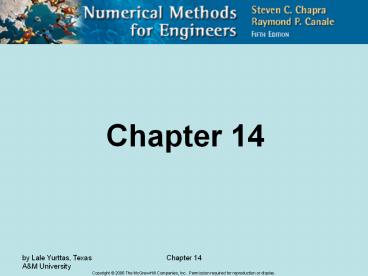Multidimensional Unconstrained Optimization Chapter 14 PowerPoint PPT Presentation
Title: Multidimensional Unconstrained Optimization Chapter 14
1
Chapter 14
2
Multidimensional Unconstrained OptimizationChapte
r 14
- Techniques to find minimum and maximum of a
function of several variables are described. - These techniques are classified as
- That require derivative evaluation
- Gradient or descent (or ascent) methods
- That do not require derivative evaluation
- Non-gradient or direct methods.
3
Figure 14.1
4
DIRECT METHODSRandom Search
- Based on evaluation of the function randomly at
selected values of the independent variables. - If a sufficient number of samples are conducted,
the optimum will be eventually located. - Example maximum of a function
- f (x, y)y-x-2x2-2xy-y2
- can be found using a random number generator.
5
- Figure 14.2
6
- Advantages/
- Works even for discontinuous and
nondifferentiable functions. - Disadvantages/
- As the number of independent variables grows, the
task can become onerous. - Not efficient, it does not account for the
behavior of underlying function.
7
Univariate and Pattern Searches
- More efficient than random search and still
doesnt require derivative evaluation. - The basic strategy is
- Change one variable at a time while the other
variables are held constant. - Thus problem is reduced to a sequence of
one-dimensional searches that can be solved by
variety of methods. - The search becomes less efficient as you approach
the maximum.
8
- Figure 14.3
9
GRADIENT METHODSGradients and Hessians
- The Gradient/
- If f(x,y) is a two dimensional function, the
gradient vector tells us - What direction is the steepest ascend?
- How much we will gain by taking that step?
Directional derivative of f(x,y) at point xa and
yb
10
Figure 14.6
- For n dimensions
11
- The Hessian/
- For one dimensional functions both first and
second derivatives valuable information for
searching out optima. - First derivative provides (a) the steepest
trajectory of the function and (b) tells us that
we have reached the maximum. - Second derivative tells us that whether we are a
maximum or minimum. - For two dimensional functions whether a maximum
or a minimum occurs involves not only the partial
derivatives w.r.t. x and y but also the second
partials w.r.t. x and y.
12
Figure 14.8
- Figure 14.7
13
- Assuming that the partial derivatives are
continuous at and near the point being evaluated
The quantity H is equal to the determinant of a
matrix made up of second derivatives
14
The Steepest Ascend Method
Figure 14.9
- Start at an initial point (xo,yo), determine the
direction of steepest ascend, that is, the
gradient. Then search along the direction of the
gradient, ho, until we find maximum. Process is
then repeated.
15
- The problem has two parts
- Determining the best direction and
- Determining the best value along that search
direction. - Steepest ascent method uses the gradient approach
as its choice for the best direction. - To transform a function of x and y into a
function of h along the gradient section
h is distance along the h axis
16
- If xo1 and yo2

